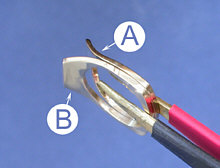Fixturing Using Welding Technology
Fixturing is a technique of using tack- and/or pulse-arc welding technology to temporarily position parts prior to soldering, pulse-arc or laser-welding. Repair, reconstruction, assembly, custom manufacturing and mass production all become more proficient using it. The following examples show applications of fixturing, how it was accomplished, the settings used and how it makes your work more proficient.
2 Minute Read
"Fixturing" is a technique of using tack- and/or pulse-arc welding technology to temporarily position parts prior to soldering, pulse-arc or laser-welding. Repair, reconstruction, assembly, custom manufacturing and mass production all become more proficient using it. The following examples show applications of "fixturing", how it was accomplished, the settings used and how it makes your work more proficient.
18 Karat Yellow Gold Ring Assembly
Platinum Earring Assembly
Repairing a Nose-Piece on Eyeglasses Frames
Important
Tack-, fusion- and pulse-arc-welding equipment settings will differ and are based upon the volume, amount of contact and alloy of the material you are working with. Practicing using like materials will give you a parameter for the settings required for your application. Keep a record of settings and tasks for future reference.
–
You assume all responsibility and risk for the use of the safety resources available on or through this web page. The International Gem Society LLC does not assume any liability for the materials, information and opinions provided on, or available through, this web page. No advice or information provided by this website shall create any warranty. Reliance on such advice, information or the content of this web page is solely at your own risk, including without limitation any safety guidelines, resources or precautions, or any other information related to safety that may be available on or through this web page. The International Gem Society LLC disclaims any liability for injury, death or damages resulting from the use thereof.
The All-In-One Jewelry Making Solution At Your Fingertips
When you join the Ganoksin community, you get the tools you need to take your work to the next level.
Trusted Jewelry Making Information & Techniques
Sign up to receive the latest articles, techniques, and inspirations with our free newsletter.
